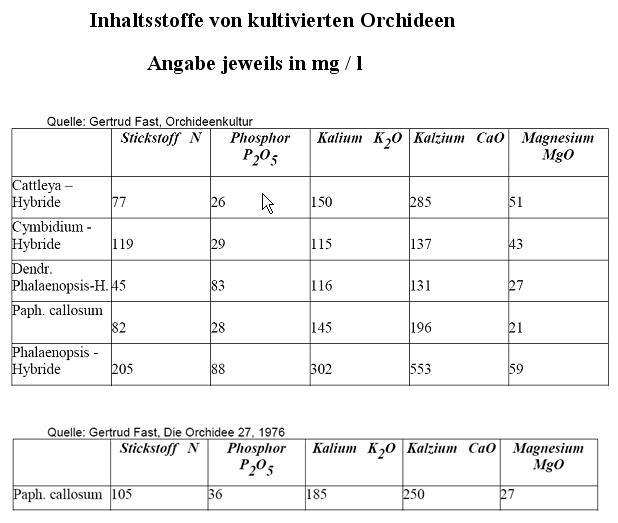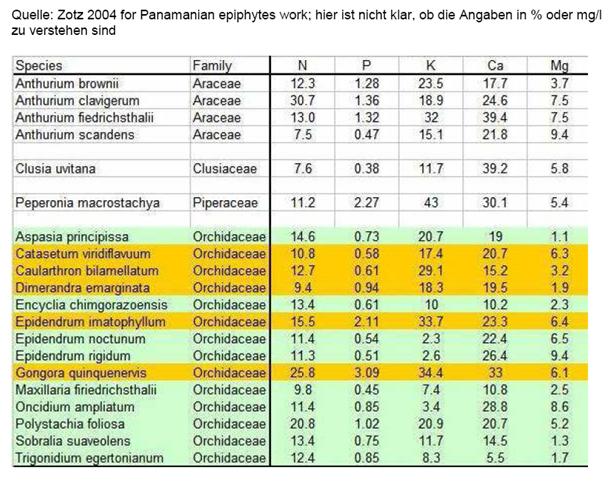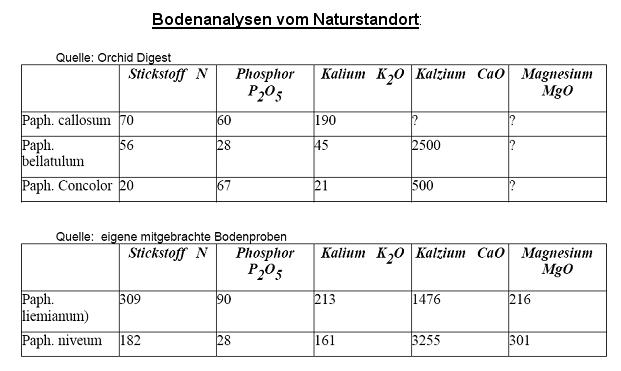water and fertilizer
According to recent research from the rainforest, the enormous amount of solar radiation combined with the heat and the immense precipitation (as rain but also as dew) are primarily responsible for successful photosynthesis and thus for growth.
In contrast to the agricultural industry, theses are being put forward today that fertilizers do not cause growth but only support growth.
The growth patterns of plants are genetically determined and are influenced by light, heat, water and air. Growing (whether vegetative growth or flowering growth) consumes nutrients that need to be replaced.
But which nutrients are important?
Today there is an almost unmanageable variety of plant fertilizers that have been derived from agricultural horticulture. Orchid fertilizers often only differ in concentration and possibly in price.
Basics of fertilization:
Irrigation water is an important component in orchid culture.
Two measured values are mentioned again and again in connection with irrigation water and fertilizer:
PH value
The pH value measures the free hydrogen ions in a solution and can be changed by adding acids or bases.
Beneficial values for orchids should range between pH 5 - 7, it seems more important that the pH value does not change with each watering process.
Conductance
the substances dissolved in the water in ionic form cause electrical conductivity.
The electrical resistance between 2 electrodes is measured.
The measurement results always refer to 25 ° C - a conversion to the temperature of the water is not necessary since most measuring devices have temperature-compensation.
In orchid culture the conductance is usually given in microsiemens (µS).
The conductance is often given as EC (electrical conductivity) but the unit of measurement is milliSiemens, i.e. EC 0.5 corresponds to 500 µS !!!
Water salinity:
Fully desalinated, distilled or
Osmosis water < 10 µS
Rainwater 30 - 60 µS
Well water 200 – 500 µS
Tap water 150 – 900 µS
The specification of the salt content says nothing about the ingredients of the water.
For orchids that are weak consumers, the salt content of the starting water should be as low as possible.
Starting water with more than 300 µS should always be mixed with rainwater or distilled water or similar. However, one should note that when tap water is added, salts get into the irrigation water that the orchids do not need and thus unnecessarily pollute the irrigation water. It is better to add all the necessary nutritional elements. The easiest way is to use rainwater. When it rains, water is allowed to run off for a while before it is directed into the rain barrels. Rainwater accumulations must always be covered to prevent dirt. Aerating the water would be helpful but is not essential. Good irrigation water is also osmosis water or water from a full desalination system (further information can be found on the internet).
Fertilizer
First, a few simple rules:
A slight lack of fertilizer does little harm and is quickly remedied. In the case of over-fertilization, the nutrient salts accumulate in the soil and make the plant material too salty - the roots die off quickly and the whole plant often dies. The only thing that helps here is to water the pot several times in pure rainwater or, even better, to repot the orchid.
What nutrients do orchids need?
Nutrient:
Nitrogen (N): Plants need N for growth, too much of it causes the cells to swell (plants become effeminate)
Phosphorus (P): The plant needs P primarily during rooting and flowering
Potassium (K): Plants need potassium for many processes in growth and flowering - too much sodium, ammonium nitrate or calcium can, however, block potassium absorption
Magnesium (Mg): Magnesium deficiency is relatively common because the plant needs a lot of it at every stage of its development and many fertilizers contain little or no Mg. Mg deficiency can be remedied with Epsom salts
Sodium (Na) is said to be insignificant as a nutrient or even to have a toxic effect - although considerable amounts have been detected in rainwater analyzes and water bodies in the tropics
Calcium (Ca): You can read again and again that orchids and especially epiphytes do not need lime, although Ca is a vital mineral for all plants. All orchids need calcium!
It should be well known that substrates based on peat and/or bark have to be limed. Usually you take 5 grams of carbonate of lime (garden lime = calcium carbonate) for one liter of plant material. This liming serves less to supply the plants with Ca but to increase the pH value of the plant matter.
Trace elements, as the name already suggests, are only required in small amounts. Many fertilizers contain a number of trace elements. Trace elements can only be absorbed in plant matter at a pH of 5-6.5.
Dosing of fertilizer
In the orchid literature or in forums one often finds the indication that orchids should be fertilized with 200 or 500 µS - a statement without any value.
As long as it is not explained what salt content the starting water has and what concentration of which fertilizer was dosed, this information is meaningless.
Maximum beneficial fertilizer values have been defined as follows in the book "Orchidenkultur, von Gertrud Fast":
Nitrogen 67 - 135 mg/l
Phosphorus 53 - 106 mg/l
Potassium 67 - 135 mg/l
The lower value is for smaller and sensitive natural forms, the upper value for heavily consuming orchids and their hybrids.
The ingredients should be declared on every purchased fertilizer:
Example:
Compo Complete Fertilizer (Liquid Fertilizer)
According to the manufacturer, 1 liter of fertilizer contains:
6% N total nitrogen = 60 g/l
4% P2O5 water soluble phosphate = 40g/L
6% K2O water soluble potassium oxide = 60g/L
2% CaO water soluble calcium oxide = 20 g/l
2% MgO water soluble magnesium oxide = 20 g/l
0.014% B water soluble boron = 140mg/L
0.003% Cu water soluble copper as chelate = 30mg/L
0.093% Fe water-soluble iron as chelate = 930 mg / l
0.013% Mn water-soluble manganese as chelate = 130 mg / l
0.001% Mo water soluble molybdenum = 13mg/L
0.003% Zn water-soluble zinc as chelate = 30 mg / l
If I now take 1 ml of it in 1 liter of water, the following nutrients are supplied to the plant (the conductivity increases by about 600 µS):
60 mg N
40 mg P2O5
60 mg K2O
20 mg CaO
20 mg MgO
0.14 mg B
0.03 mg Cu
0.93 mg Fe
0.13mg Mn
0.01mg Mo
0.03 mg Zn
Scott Professional Cal Mag (salt fertilizer)
According to the manufacturer, 1 liter of fertilizer contains:
15% N total nitrogen = 150 g/l
5% P2O5 water soluble phosphate = 50g/L
15% K2O water soluble potassium oxide = 150g/L
7% CaO water-soluble calcium oxide = 70 g/l
3% MgO water-soluble magnesium oxide = 70 g/l
0.020% B water soluble boron = 200mg/L
0.015% Cu water soluble copper as chelate = 150 mg/l
0.120% Fe water-soluble iron as chelate = 1200 mg / l
0.060% Mn water-soluble manganese as chelate = 600 mg / l
0.010% Mo water soluble molybdenum = 100mg/L
0.015% Zn water-soluble zinc as chelate = 150 mg / l
If I now take 1 gram of it in 1 liter of water, the following nutrients are supplied to the plant (the conductivity increases by about 1100 µS):
150 mg N
50 mg P2O5
150 mg K2O
70 mg CaO
30 mg MgO
0.20mg B
0.15 mg Cu
1.20 mg Fe
0.60mg Mn
0.10mg Mo
0.15 mg Zn
Note: this concentration is more commonly used in commercial horticulture for the production of hybrid orchids.
If I take half the concentration (1 gram in 2 liters of water), the following values result for the main nutrients (the conductance increases by 550 µS in eta):
75 mg N
25 mg P2O5
75 mg K2O
35 mg CaO
15 mg MgO
Note: this concentration is often used as permanent fertilization in the orchid culture of natural forms (exceptions possible).
Anyone who has read this far with interest will ask themselves: why all these nutritional information?
Basically, the question arises: can I feed the orchids properly with the fertilizers I use?
Leaf analyzes of orchids, which I have compiled here from various sources, serve as clues:




The average nutrient requirements for orchids (mg/L) are calculated as follows:
N=90
P2O5 = 30
K2O = 90
CaO > 90
MgO = 30
The fertilizers Compo Complete or Scott Professional Cal Mag mentioned in the first part are already close in terms of the ratio of the nutrient elements.
Most fertilizers lack calcium and magnesium as important nutrient elements.
You can supplement these missing nutrients with nitrate of lime and Epsom salt - then you can continue to use your previous orchid fertilizer.
Example:
1 g / 1 l nitrate of lime (here: calcinite from Yara) contains:
150 mg N and 265 mg CaO and increases the salt content by 1400 µS
better:
1 g / 3 l contains 50 mg N and 88 mg CaO and increases the salt content by 460 µS
or:
1 g / 4 l contains 38 mg N and 66 mg CaO and increases the salt content by 350 µS
The nitrate of lime should only be dissolved in rainwater, i.e. used without any other fertilizer.
1 g / 1 l Epsom salt (magnesium sulphate) from garden supplies
160 mg MgO and 130 mg S increases the salt content by 950 µS
1 g / 5 L contains 32 mg MgO and increases the salt content by approx. 200 µS
Epsom salt can be applied along with other fertilizers.
Choosing the "right" starting water and fertilizer is an essential factor in orchid cultivation. However, temperature, light, fresh air and the right watering behavior are almost as important.
For example, Akerne Orchideen (Belgium) uses the following fertilizer:
Akerne's Rain Mix - 13 N + 3 P205 + 15 k2O + 11 CaO + 3 MgO + trace elements
in the following dosage 0.5 g per liter (5 g per 10 liters) rainwater
this corresponds to a conductance of about 550 µS - watering is carried out regularly throughout the year for all natural forms!
This adds the following nutrients to the plants with each watering:
65 mg N
15 mg P2O5
75 mg K2O
55 mg CaO
15 mg MgO
+ trace elements
for Phal. Hybrids, the concentration can be doubled (1 g per liter of rainwater). This fertilizer is based on the MSU fertilizer from the USA, which is unfortunately not available in Europe. The MSU fertilizer was developed at Michigan State University and has been successfully tested by many orchid enthusiasts and companies over many years. This fertilizer comes very close to foliar analysis of various orchids.


